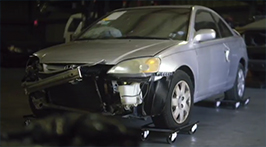Overview
Shear presses are used primarily for the shaping of sheet metal. Other applications can be found in the plastics industry, where the machines are also used for shaping purposes. In many cases the shear press is not a stand-alone instrument, but instead is combined with a press brake to provide both shaping and cutting capabilities. The units have a base to provide stability, power or hydraulic inputs, shaping arms, rollers, and material feed gauges.
Shear presses can be powered by pneumatics, electricity, or hydraulic processes. The machines work by providing targeted pressure to the material in order to give it a specific shape or to generate coils. Shear presses may also use heat in addition to pressure to provide bending and shaping action.
Shear Press Defects and Failures
As a result of the intense heat and pressure, shear presses need to be able to withstand extremes without failure. Product failures can include losses in system pressure, overheating, or failures of safety mechanisms.
Shear presses most often suffer defects related to their power or pressure supplies. The machines can become very hot during use, and the high pressure levels can cause power systems to overheat. Electrical shorts are also a cause for concern with shear presses.
For shear presses powered by hydraulics, maintenance of the pressure system is critical. Failure to properly maintain the pressure system can result in sudden pressure failures, causing a variety of injuries. Safety guards may also fail on occasion, leading to jamming of materials, system failures, and severe injuries.
Shear Press Injuries
Shear presses are commonly included in safety programs designed by the U.S. Department of Labor’s Occupational Safety and Health Administration (OSHA) and others to prevent injuries. From 2002 to 2007, shear presses were included in the National Elimination Program for Amputation Risk run by OSHA. The campaign aimed to reduce the incidence of injuries by placing more emphasis on education and worker safety.
The most common injuries related to the use of shear presses are finger injuries. In most cases cited by OSHA, these injuries were caused by finger safety guards being bent back out of the appropriate position. Safety regulation violation caused most shear press injuries.
In the late 1970s and early 1980s incidence of injury among shear press and power press operators was higher. According to the Bureau of Labor Statistics, 10 percent of occupational injuries during that time period were to press operators, and 49 percent of those injuries resulted in full or partial amputation. Subsequent machine redesigns, additions of safety equipment, and changes in worker habits dramatically reduced those numbers.
Sources
- BLS. (1982). Work-related hand injuries and upper extremity amputations. Washington, D.C.: Bureau of Labor Statistics, Bulletin 2160
- SPI Plastics Industry Trade Association. (2006). “Issue Brief – OSHA National Emphasis Program on Amputations”. Worker Safety. October.
